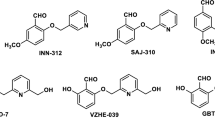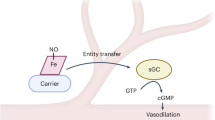Abstract
The coupling of hemoglobin sensing of physiological oxygen gradients to stimulation of nitric oxide (NO) bioactivity is an established principle of hypoxic blood flow. One mechanism proposed to explain this oxygen-sensing–NO bioactivity linkage postulates an essential role for the conserved Cys93 residue of the hemoglobin β-chain (βCys93) and, specifically, for S-nitrosation of βCys93 to form S-nitrosohemoglobin (SNO-Hb)1. The SNO-Hb hypothesis, which conceptually links hemoglobin and NO biology, has been debated intensely in recent years2,3. This debate has precluded a consensus on physiological mechanisms and on assessment of the potential role of SNO-Hb in pathology. Here we describe new mouse models that exclusively express either human wild-type hemoglobin or human hemoglobin in which the βCys93 residue is replaced with alanine to assess the role of SNO-Hb in red blood cell–mediated hypoxic vasodilation. Substitution of this residue, precluding hemoglobin S-nitrosation, did not change total red blood cell S-nitrosothiol abundance but did shift S-nitrosothiol distribution to lower molecular weight species, consistent with the loss of SNO-Hb. Loss of βCys93 resulted in no deficits in systemic or pulmonary hemodynamics under basal conditions and, notably, did not affect isolated red blood cell–dependent hypoxic vasodilation. These results demonstrate that SNO-Hb is not essential for the physiologic coupling of erythrocyte deoxygenation with increased NO bioactivity in vivo.
This is a preview of subscription content, access via your institution
Access options
Subscribe to this journal
Receive 12 print issues and online access
$209.00 per year
only $17.42 per issue
Buy this article
- Purchase on Springer Link
- Instant access to full article PDF
Prices may be subject to local taxes which are calculated during checkout




Similar content being viewed by others
References
Singel, D.J. & Stamler, J.S. Chemical physiology of blood flow regulation by red blood cells: the role of nitric oxide and S-nitrosohemoglobin. Annu. Rev. Physiol. 67, 99–145 (2005).
Crawford, J.H., Chacko, B.K., Kevil, C.G. & Patel, R.P. The red blood cell and vascular function in health and disease. Antioxid. Redox Signal. 6, 992–999 (2004).
Gladwin, M.T., Lancaster, J.R. Jr., Freeman, B.A. & Schechter, A.N. Nitric oxide's reactions with hemoglobin: a view through the SNO-storm. Nat. Med. 9, 496–500 (2003).
Gonzalez-Alonso, J., Richardson, R.S. & Saltin, B. Exercising skeletal muscle blood flow in humans responds to reduction in arterial oxyhaemoglobin, but not to altered free oxygen. J. Physiol. (Lond.) 530, 331–341 (2001).
Gladwin, M.T. et al. Nitrite as a vascular endocrine nitric oxide reservoir that contributes to hypoxic signaling, cytoprotection, and vasodilation. Am. J. Physiol. Heart Circ. Physiol. 291, H2026–H2035 (2006).
Ellsworth, M.L. The red blood cell as an oxygen sensor: what is the evidence? Acta Physiol. Scand. 168, 551–559 (2000).
Sprague, R.S., Stephenson, A.H. & Ellsworth, M.L. Red not dead: signaling in and from erythrocytes. Trends Endocrinol. Metab. 18, 350–355 (2007).
Jia, L., Bonaventura, C., Bonaventura, J. & Stamler, J.S. S-nitrosohaemoglobin: a dynamic activity of blood involved in vascular control. Nature 380, 221–226 (1996).
Stamler, J.S. et al. Blood flow regulation by S-nitrosohemoglobin in the physiological oxygen gradient. Science 276, 2034–2037 (1997).
Pawloski, J.R., Hess, D.T. & Stamler, J.S. Export by red blood cells of nitric oxide bioactivity. Nature 409, 622–626 (2001).
McMahon, T.J. et al. Nitric oxide in the human respiratory cycle. Nat. Med. 8, 711–717 (2002).
Gow, A.J. & Stamler, J.S. Reactions between nitric oxide and haemoglobin under physiological conditions. Nature 391, 169–173 (1998).
Datta, B. et al. Red blood cell nitric oxide as an endocrine vasoregulator: a potential role in congestive heart failure. Circulation 109, 1339–1342 (2004).
James, P.E., Lang, D., Tufnell-Barret, T., Milsom, A.B. & Frenneaux, M.P. Vasorelaxation by red blood cells and impairment in diabetes: reduced nitric oxide and oxygen delivery by glycated hemoglobin. Circ. Res. 94, 976–983 (2004).
Bennett-Guerrero, E. et al. Evolution of adverse changes in stored RBCs. Proc. Natl. Acad. Sci. USA 104, 17063–17068 (2007).
McMahon, T.J. et al. A nitric oxide processing defect of red blood cells created by hypoxia: deficiency of S-nitrosohemoglobin in pulmonary hypertension. Proc. Natl. Acad. Sci. USA 102, 14801–14806 (2005).
Reynolds, J.D. et al. S-nitrosohemoglobin deficiency: a mechanism for loss of physiological activity in banked blood. Proc. Natl. Acad. Sci. USA 104, 17058–17062 (2007).
Cheng, Y., Shen, T.J., Simplaceanu, V. & Ho, C. Ligand binding properties and structural studies of recombinant and chemically modified hemoglobins altered at β93 cysteine. Biochemistry 41, 11901–11913 (2002).
Crawford, J.H. et al. Hypoxia, red blood cells and nitrite regulate NO-dependent hypoxic vasodilation. Blood 107, 566–574 (2006).
Huang, Z. et al. Enzymatic function of hemoglobin as a nitrite reductase that produces NO under allosteric control. J. Clin. Invest. 115, 2099–2107 (2005).
Patel, R.P. et al. Biochemical characterization of human S-nitrosohemoglobin. Effects on oxygen binding and transnitrosation. J. Biol. Chem. 274, 15487–15492 (1999).
Palmer, L.A. et al. S-nitrosothiols signal hypoxia-mimetic vascular pathology. J. Clin. Invest. 117, 2592–2601 (2007).
Pawloski, J.R., Hess, D.T. & Stamler, J.S. Impaired vasodilation by red blood cells in sickle cell disease. Proc. Natl. Acad. Sci. USA 102, 2531–2536 (2005).
Liu, L. et al. Essential roles of S-nitrosothiols in vascular homeostasis and endotoxic shock. Cell 116, 617–628 (2004).
Crawford, J.H. et al. Transduction of NO bioactivity by the red blood cell in sepsis: novel mechanisms of vasodilation during acute inflammatory disease. Blood 104, 1375–1382 (2004).
Doctor, A. et al. Hemoglobin conformation couples erythrocyte S-nitrosothiol content to O2 gradients. Proc. Natl. Acad. Sci. USA 102, 5709–5714 (2005).
Wu, L.C. et al. Correction of sickle cell disease by homologous recombination in embryonic stem cells. Blood 108, 1183–1188 (2006).
Chen, Y.F. et al. Atrial natriuretic peptide–dependent modulation of hypoxia-induced pulmonary vascular remodeling. Life Sci. 79, 1357–1365 (2006).
Lang, J.D. et al. Inhaled NO accelerates restoration of liver function in adults following orthotopic liver transplantation. J. Clin. Invest. 117, 2583–2591 (2007).
Chidlow, J.H., Jr. et al. Differential angiogenic regulation of experimental colitis. Am. J. Pathol. 169, 2014–2030 (2006).
Acknowledgements
This study was supported by grants from the US National Institutes of Health (HL057619) to T.M.T., from the American Heart Association, Southeast Affiliate (AHA 0655312B) to R.P.P. and from the Alabama Neuroscience Blueprint Core Center (NS 057098). T.S.I. was supported by a Cardiovascular Pathophysiology Training Fellowship. We also thank T. Lowder and M. Hewitt for technical assistance in exercise studies.
Author information
Authors and Affiliations
Contributions
T.S.I., C.-W.S., L.-C.W., X.T., D.A.V. and K.M.P. were responsible for performing experiments. T.S.I., C.-W.S., D.A.V., R.P.P. and T.M.T. were responsible for planning all experiments, analyzing data and writing the manuscript. M.B.R. contributed to mass spectrometry assays, L.S. was responsible for exercise-related studies, C.G.K. and B.G.B. were responsible for capillary density measurements, N.P. and J.M.W. contributed to blood pressure measurements and N.A. assessed pulmonary hemodynamics. J.R. did the embryonic stem cell injections to generate the chimeras.
Corresponding authors
Supplementary information
Supplementary Text and Figures
Supplementary Table 1, Supplementary Figs. 1–7 and Supplementary Methods (PDF 1201 kb)
Rights and permissions
About this article
Cite this article
Isbell, T., Sun, CW., Wu, LC. et al. SNO-hemoglobin is not essential for red blood cell–dependent hypoxic vasodilation. Nat Med 14, 773–777 (2008). https://doi.org/10.1038/nm1771
Received:
Accepted:
Published:
Issue Date:
DOI: https://doi.org/10.1038/nm1771
This article is cited by
-
Microcirculation dysfunction in endotoxic shock rabbits is associated with impaired S-nitrosohemoglobin-mediated nitric oxide release from red blood cells: a preliminary study
Intensive Care Medicine Experimental (2019)
-
Nitric oxide signalling in cardiovascular health and disease
Nature Reviews Cardiology (2018)
-
Can erythrocytes release biologically active NO?
Cell Communication and Signaling (2016)
-
Erythrocytes do not activate purified and platelet soluble guanylate cyclases even in conditions favourable for NO synthesis
Cell Communication and Signaling (2016)
-
Sepsis impairs microvascular autoregulation and delays capillary response within hypoxic capillaries
Critical Care (2015)



